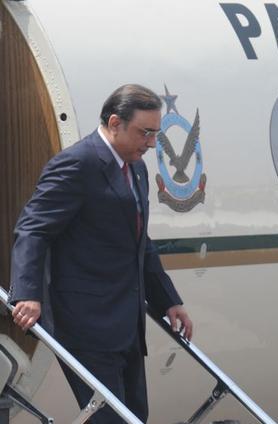
New Delhi, April 8: In a first visit by a Pakistan President in seven years, Asif Ali Zardari arrived in New Delhi on Sunday for a brief stopover to join Prime Minister Manmohan Singh for a lunch that will be preceded by a one-on-one meeting during which they will discuss crucial bilateral issues.
Mr. Zardari, who landed here at 12.10 pm at Palam Air Force Base (technical area) along with his son and heir apparent Bilawal Bhutto, Interior Minister Rehman Malik and some senior officials, was received by minister-in-waiting P K Bansal, Foreign Secretary Ranjan Mathai and Pakistan High Commissioner Shahid Malik among others.
Attired in a dark coloured business suit, Mr. Zardari waved at the mediamen but did not oblige them with any comments. He straight drove to the Prime Minister’s official Race Course Road residence.
Here on a day-long “private visit”, 56-year-old Mr. Zardari will fly to Ajmer to pay obeisance at the shrine of Khwaja Moinuddin Chishti after his meeting with Dr. Singh.
The issue of terrorism and presence of those involved in anti-India activities in Pakistan is likely to figure in the meeting between Zardari and Singh, given that there is a renewed pressure on Islamabad to take action against JuD chief Hafiz Saeed after the US announcement of $ 10 million bounty for information leading to the prosecution of the LeTa founder.
The meeting is also seen as very significant in the backdrop of improving ties between the two countries with increased Confidence Building Measures (CBMs) to bolster cross LoC trade.
Though there is no structured agenda for the meeting, the two leaders are expected to talk on issues of mutual concern.
Mr. Zardari and Dr. Singh will meet on Sunday after almost three years. They had last met in Yekaterinburg in Russia in 2009.





Comments
Add new comment